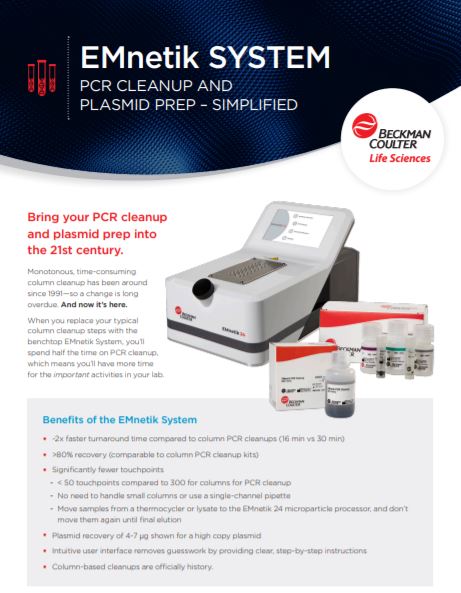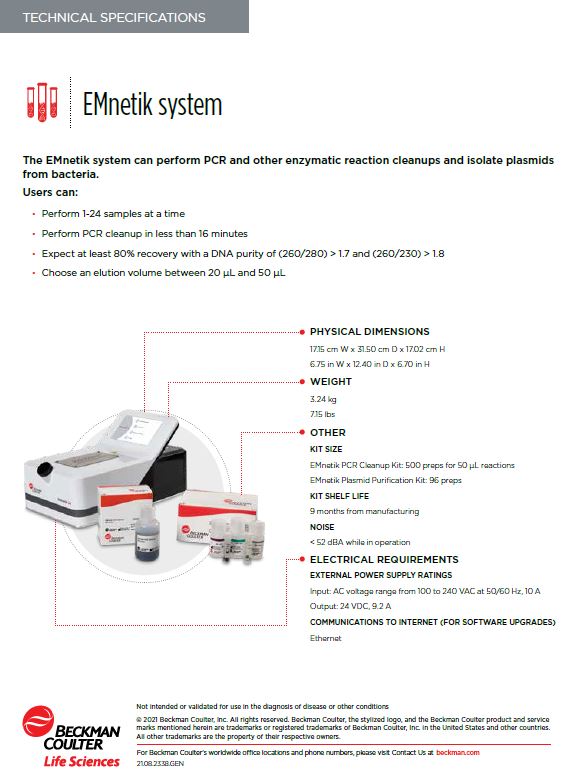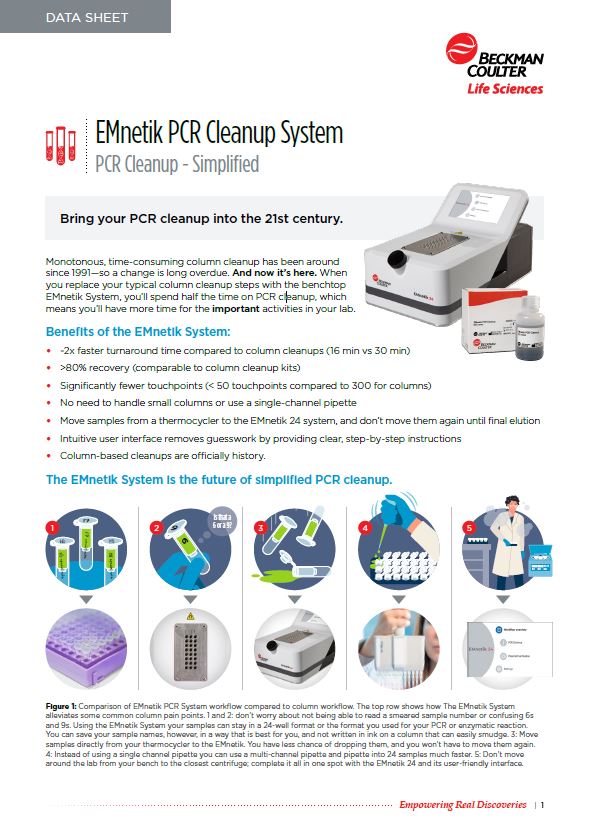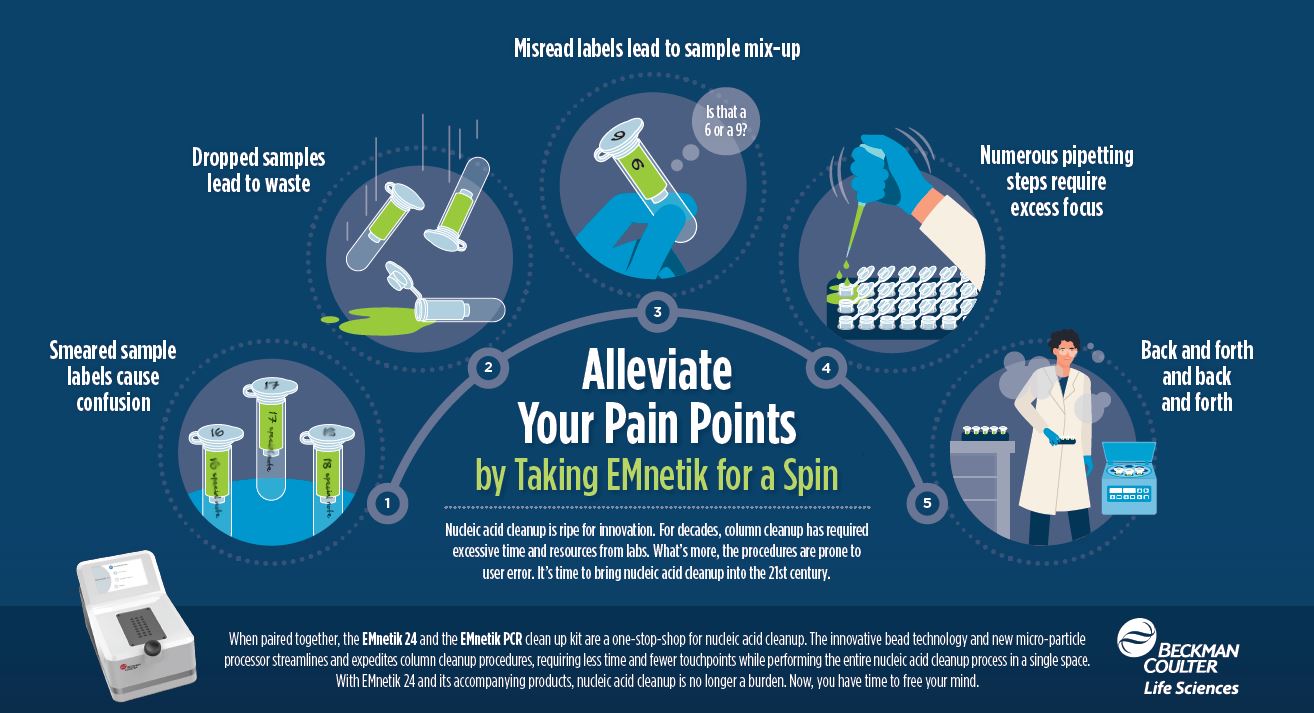EMnetik PCR Cleanup Limits
- The EMnetik PCR Cleanup kit supports sample input and elution volumes ranging from 20 µL to 50 µL. Any changes outside of this range could result in lower yields. We suggest 50 µL elution volume, but the EMnetik 24 microparticle processor supports volumes as low as 20 µL; be aware that lower elution volumes may decrease yields and purity.
- Concentration Limits: 800 ng/µL and with fragment sizes up to 10 kilobases
- Size Limits: Does not currently support gDNA
EMnetik PCR Cleanup FAQs
Q: Bind vortexing – How many times should I pipette mix before I add the beads?
A: The bottle needs to be vortexed for 30 seconds, but you can pipette mix aliquoted bead buffer in a reagent reservoir at least 10 times or until completely mixed.
Q: Can I use non-recommended tube/plate types?
A: EMnetik PCR Cleanup has been optimized with the recommended tube/plate types. Further optimization may be required when using other consumables. It is important that tubes/plates have full contact with the bottom of the tube holder for optimal mixing and DNA recovery
Q: Can I use other magnetic beads?
A: No, unsupported beads will not mix well and will result in significant yield loss.
Q: Will the EMnetik PCR Cleanup bead reagent do size selection, like AMPureXP and SPRISelect?
A: These beads are not recommended for size selection of nucleic acids.
Q: Can I reduce the amount of EMnetik PCR Cleanup reagent per sample volume?
A: No, the EMnetik PCR Cleanup reagent needs to be at 1.8× ratio to sample volume for optimal mixing.
Q: Can I run the Bind mix & separate step for additional time?
A: If you want to optimize your bind time, you can re-run the bind mix step by highlighting and clicking the Bind mix & separate step in the user interface. This is particularly useful if you have very high or very low concentrations of DNA. NOTE When running the Bind mix & separate step additional times, run the Initialize & add reagent step in between to reset the magnets.
Q: Can I elute in TE buffer?
A: Yes, TE buffer is a compatible elution buffer. We have seen in some cases that elution in water has a slightly higher yield.
Q: Can I elute longer than the designated time?
A: If you want to optimize your elution time you can re-run the elution mix step by pressing the Elution mix & separate icon in the user interface. This is particularly useful if you have over dried your beads. NOTE When running the Elution mix & separate step additional times, run the Initialize and add reagent step in between to reset the magnets.
EMnetik PCR Cleanup Troubleshooting
Low Yields:
| Possible Causes |
Possible Solutions and Information |
Insufficient mixing of EMnetik PCR Cleanup reagent
|
Ensure bead reagent bottle is mixed for the full 30 seconds right before use, even if it looks mixed. When using reagent reservoirs, transfer mixed bead reagent into reservoir and use immediately.
|
| Bead loss |
Bead loss during aspiration: Avoid touching beads with pipette tip during aspirations. If you aspirate beads into the pipette tip, dispense back into tube or well and let it settle toward the magnet before aspirating again. Bead loss due to insufficient clearing: Make sure to wait for the protocol step to show Done in addition to visually confirming that beads have pelleted to the side of the tube/well before aspirating and discarding supernatant.
|
| Low ethanol concentration |
Ethanol is hygroscopic and may become more dilute over time. Prepare fresh 75% ethanol every day for optimal results.
|
| DNase contamination |
Ensure that DNase is not a source of contamination during the isolation processes. Avoid touching pipette tips to non-sterile surfaces.
|
| Overdried beads |
Make sure beads do not dry longer than the time specified in the protocol.
|
| Incomplete elution |
Ensure that the elution buffer reaches the beads and that there are no droplets sticking to the sides of the well/tube.
|
Using non-recommended tube or plate types
|
Non-recommended tube or plate types may sit too high off the instrument for effective mixing. Make sure tubes and plates are of recommended types.
|
Low Purity:
| Possible Causes |
Possible Solutions and Information |
High ethanol concentration
|
Ethanol wash concentration may be lowered to 70% to increase purity, but you might see some loss of yield.
|
Ethanol Carryover:
| Possible Causes |
Possible Solutions and Information |
Incomplete removal of ethanol
|
Use 20 µL or gel-loading tips to remove ethanol. Remove droplets from the side of the tube. To move the droplets to the bottom for easier removal, remove the plate from the device and lightly tap, if needed. Pipette from the bottom of the well. Make sure to completely remove visible ethanol before the Ethanol dry & add eluent step. Make sure the Ethanol Dry time is sufficient and there are no visible droplets of ethanol in the tube before Elution.
|
Ethanol is caught by bead pellet
|
Remove from the device and allow the beads to settle (30 seconds), and then return to the magnet and remove extra ethanol. Samples can also be centrifuged briefly to remove the beads from the side of the tube before returning to the magnet. Please note, some beads may not return to the magnet. However, if care is taken to remove the ethanol without the beads, they will be recovered when water is added for elution. Longer dry time; this can also be paired with the above guidance.
|
Cannot determine if ethanol remains
|
Remove from the device and examine; return the plate to device and allow the beads to pellet again (10 seconds) before removing additional ethanol.
|
EMnetik Plasmid Purification FAQs
Q: Can I use different sample volumes?
A: This protocol has been optimized for a reaction volume which can work with the EMnetik 24. Adding more or less sample will affect the sample to isopropanol and bead concentration ratios and also decrease yield the isopropanol and bead concentrations and also decrease yield due to incomplete mixing.
Q: Can I go below 50 µL for the elution volume?
A: We suggest 50 µL elution volume, but the EMnetik 24 microparticle processor supports volumes as low as 20 µL; be aware that lower elution volumes may decrease yields and purity.
Q: Can I add the beads and isopropanol together ahead of time?
A: Beads and isopropanol can be combined up to 30 minutes ahead of transfer to mixer; however, efficiency and yield may decline after 15 minutes.
Q: Do I need to mix beads at every step?
A: Yes, you need to mix the beads every time. The beads have tendency to settle quickly; not mixing the beads will result in incorrect amount of beads in reaction. Internal testing has shown the performance decreases without full mixing.
Q: Do I need to vortex for 30 seconds?
A: Yes, when vortexing is listed for 30 seconds, this is required for optimal performance. Vortexing the PLP bottle for 10 seconds instead of 30 seconds will lead to d
Q: Can I use other beads?
A: No, unsupported beads will not mix well and will result in significant yield loss.
Q: Can I reduce the amount of beads per sample volume?
A: No, bead buffer needs to be at exact isopropanol to bead ratio for them to mix optimally
Q: Can I run the Bind Mix & Separate step for additional time?
A: If you want to optimize your bind time, you can re-run the bind mix step by pressing the Bind mix & separate icon in the user interface. This is particularly useful if you have very high or very low concentrations of DNA, or large plasmids. Please note, when running the Bind mix & separate step additional times, run the Initialize & add reagent step in between to reset the magnets.
Q: I transferred some of the flocculant. What can I do?
A: Transferring flocculant into the bind step may result in decreased quality or gDNA carryover. If you think the flocculant has not properly pelleted, spin the lysate a little longer.
Q: Can frozen pellets be used for purification?
A: Pellets frozen at -20°C can be used for resuspension; it will generally require vortexing to fully break up frozen pellets, or allowing pellets to sit in resuspension buffer to soften for several minutes.
Q: Can performance be optimized to single tubes, as opposed to plates, for preparing the lysate?
A: Yes, there are several adjustments which can be made to reduce time and optimize performance when not working from full plates: Neutralization: Invert 5-10 times and proceed to centrifugation, instead of mixing on shaker for 10 minutes. Centrifugation: Halve the time to 10 minutes and increase speed to >10,000 rcf.
EMnetik Plasmid Purification Troubleshooting
Low Yields:
| Possible Causes |
Possible Solutions and Information |
Beads Not Mixed
|
Fully homogenize beads at all mix steps.
|
Isopropanol/Bead Concentration Incorrect
|
Ensure beads are fully mixed before transferring to wells. Double check that bead and isopropanol volumes have been calculated correctly and that no drops of beads were on outside of pipette tip.
|
Not Enough Cells
|
If the cell pellets appear small or the measured cell density is low, adjust growth parameters to obtain a healthy culture. Be sure to pellet cells while still on the log phase. Do not add too much or too little antibiotic. Grow cells in appropriate media. Ensure cultures are agitated enough during incubation and receive enough oxygen. Optimize the amount of inoculum used. Ensure the pre-culture is healthy and not overgrown. Ensure all cells are pelleted during centrifugation step and that pellets are not dislodged during decanting. Pelleted cells are in death phase. Cells in the death phase can lose their plasmids, leading to decreased yield. Use a growth curve to determine when cells are entering death phase and be sure to pellet them during the growth curve.
|
Dried On Beads
|
Large plasmids can tightly bind to the beads. Avoid drying beads completely when extracting plasmids. |
Poor Mixing
|
Be sure beads are well mixed at all transfer steps. |
Bead Loss
|
Remove the supernatant only once the beads have settled and avoid aspirating any beads during the supernatant removal and the removal of the ethanol washes.
|
Labware Not Seated in EMnetik 24
|
Ensure labware is fully seated in mixer before proceeding. If using single tubes, ensure tube holding attachment has been inserted to keep tubes in place. Improperly inserted labware can result in poor mixing during bind or elution.
|
Ethanol Concentration
|
Ensure you are using freshly made 70% ethanol. As ethanol is hygroscopic, it will become more dilute over time. Lower concentrations of ethanol will cause loss of yield.
|
Incomplete Pellet Breakup
|
Vortex or mix on orbital/platform shaker for 30 seconds if pipetting is not sufficient to breakup pellet.
|
RNA in Eluate:
| Possible Causes |
Possible Solutions and Information |
Beads Not Mixed
|
Fully homogenize beads at all mix steps.
|
Isopropanol/Bead Concentration Incorrect
|
Ensure beads are fully mixed before transferring to wells. Double check that bead and isopropanol volumes have been calculated correctly and that no drops of beads were on outside of pipette tip. |
Not Enough Cells
|
If the cell pellets appear small or the measured cell density is low, adjust growth parameters to obtain a healthy culture. Be sure to pellet cells while still on the log phase. Do not add too much or too little antibiotic. Grow cells in appropriate media. Ensure cultures are agitated enough during incubation and receive enough oxygen.
Optimize the amount of inoculum used. Ensure the pre-culture is healthy and not overgrown. Ensure all cells are pelleted during centrifugation step and that pellets are not dislodged during decanting. Pelleted cells are in death phase. Cells in the death phase can lose their plasmids, leading to decreased yield. Use a growth curve to determine when cells are entering death phase and be sure to pellet them during the growth curve.
|
Dried On Beads
|
Large plasmids can tightly bind to the beads. Avoid drying beads completely when extracting plasmids. |
Poor Mixing
|
Be sure beads are well mixed at all transfer steps. |
Bead Loss
|
Remove the supernatant only once the beads have settled and avoid aspirating any beads during the supernatant removal and the removal of the ethanol washes. |
Labware Not Seated in EMnetik 24
|
Ensure labware is fully seated in mixer before proceeding. If using single tubes, ensure tube holding attachment has been inserted to keep tubes in place. Improperly inserted labware can result in poor mixing during bind or elution. |
Ethanol Concentration
|
Ensure you are using freshly made 70% ethanol. As ethanol is hygroscopic, it will become more dilute over time. Lower concentrations of ethanol will cause loss of yield. |
Incomplete Pellet Breakup
|
Vortex or mix on orbital/platform shaker for 30 seconds if pipetting is not sufficient to breakup pellet.
|
Flocculent Aspirated During Transfer:
| Possible Causes |
Possible Solutions and Information |
| Beads Not Mixed |
Fully homogenize beads at all mix steps. |
| Isopropanol/Bead Concentration Incorrect |
Ensure beads are fully mixed before transferring to wells. Double check that bead and isopropanol volumes have been calculated correctly and that no drops of beads were on outside of pipette tip. |
| Not Enough Cells |
If the cell pellets appear small or the measured cell density is low, adjust growth parameters to obtain a healthy culture. Be sure to pellet cells while still on the log phase. Do not add too much or too little antibiotic. Grow cells in appropriate media. Ensure cultures are agitated enough during incubation and receive enough oxygen. Optimize the amount of inoculum used. Ensure the pre-culture is healthy and not overgrown. Ensure all cells are pelleted during centrifugation step and that pellets are not dislodged during decanting. Pelleted cells are in death phase. Cells in the death phase can lose their plasmids, leading to decreased yield. Use a growth curve to determine when cells are entering death phase and be sure to pellet them during the growth curve.
|
| Dried On Beads |
Large plasmids can tightly bind to the beads. Avoid drying beads completely when extracting plasmids. |
| Poor Mixing |
Be sure beads are well mixed at all transfer steps. |
| Bead Loss |
Remove the supernatant only once the beads have settled and avoid aspirating any beads during the supernatant removal and the removal of the ethanol washes. |
| Labware Not Seated in EMnetik 24 |
Ensure labware is fully seated in mixer before proceeding. If using single tubes, ensure tube holding attachment has been inserted to keep tubes in place. Improperly inserted labware can result in poor mixing during bind or elution. |
Ethanol Concentration
|
Ensure you are using freshly made 70% ethanol. As ethanol is hygroscopic, it will become more dilute over time. Lower concentrations of ethanol will cause loss of yield.
|
Incomplete Pellet Breakup
|
Vortex or mix on orbital/platform shaker for 30 seconds if pipetting is not sufficient to breakup pellet.
|
Ethanol Carryover:
| Possible Causes |
Possible Solutions and Information |
Incomplete Removal of Ethanol
|
Use 20 µL or gel-loading tips to remove ethanol. Remove droplets from the side of the tube. To move the droplets to the bottom for easier removal, remove the plate from the device and lightly tap, if needed. Pipette from the bottom of the well.
|
Ethanol is Caught by Bead Pellet
|
Remove from the device and allow the beads to settle (30 seconds), and then return to the magnet and remove extra ethanol. Samples can also be centrifuged briefly to remove the beads from the side of the tube before returning to the magnet. Please note, some beads may not return to the magnet. However, if care is taken to remove the ethanol without the beads, they will be recovered when water is added for elution. Longer dry time; this can also be paired with the above guidance.
|
Cannot Determine if Ethanol Remains
|
Remove from the device and examine; return the plate to device and allow the beads to pellet again (10 seconds) before removing additional ethanol.
|
Not intended or validated for use in the diagnosis of disease or other conditions.
© 2022 Beckman Coulter, Inc. All rights reserved. Beckman Coulter, the stylized logo, and the Beckman Coulter product and service marks mentioned herein are trademarks or registered trademarks of Beckman Coulter, Inc. in the United States and other countries. All other trademarks are the property of their respective owners.





